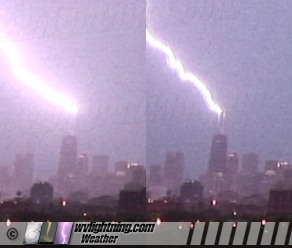MYTH: Lightning never strikes the same place twice.
|
In September of 2025, my work is generating the most income it ever has in my career. Yet, I'm being forced to shut down my successul operation, against my will, due to one cause alone: 95% of that revenue is being stolen by piracy and copyright infringement. I've lost more than $1 million to copyright infringement in the last 15 years, and it's finally brought an end to my professional storm chasing operation. Do not be misled by the lies of infringers, anti-copyright activists and organized piracy cartels. This page is a detailed, evidenced account of my battle I had to undertake to just barely stay in business, and eventually could not overcome. It's a problem faced by all of my colleagues and most other creators in the field. |
TRUTH: The old saying that 'lightning never strikes the same place twice' is another myth that any veteran storm chaser or researcher has seen nature defy. Lightning can strike any location more than once. In fact, given enough time, it is actually inevitable. It may take as little as less than ten minutes within a single thunderstorm, or longer than a million years - but lightning will eventually strike the same spot again and again. A strike to any location does nothing to change the electrical activity in the storm above, which will produce another strike as soon as it 'recharges'. The previously hit location is then just as fair game for the next discharge as any other spot.
Examples of lightning striking twice - and more!
I have seen, and captured on camera, lightning "striking the same place" on numerous occasions. Here are a few of the more notable examples:
Where does "lightning strike twice" the most?
Tall television towers and large skyscrapers are the most common places that lightning strikes recurrently. A television tower or tall skyscraper often experiences a direct strike as frequently as every thirty seconds during more intense thunderstorms, with a total of three to over a dozen strikes per every half-hour interval that a storm is overhead. A observer wishing to witness a predictable close lightning strike has to go no further than his local television tower during a storm. Towers or skyscrapers that reach or exceed the 1,000 foot mark are virtually guaranteed to take at least one direct hit during every thunderstorm that passes overhead.
ARTICLE: Lightning strikes to towers and skyscrapers
So what about your house or your favorite tree? Lightning data shows that for climates with moderate thunderstorm activity such as Pennsylvania, New York and West Virginia, lightning will strike a typical quarter-acre area of land (of course, excluding those with tall buildings or towers) once every 100 years. So, statistically speaking, for these areas you could expect lightning to strike any location again in each century. Of course, for locales with higher storm frequency such as central Florida, the repeat strikes would occur in even smaller time periods.
But lightning doesn't have to follow the statistics. Any object could be struck again at any time, even during the same storm, so don't ever assume a recent strike makes a spot safe from another strike.
Frequency of strikes to skyscrapers and towers
 RIGHT: The John Hancock Center in Chicago, its antennas rising over 1,400 feet high, is also struck by lightning multiple times during thunderstorms. RIGHT: The John Hancock Center in Chicago, its antennas rising over 1,400 feet high, is also struck by lightning multiple times during thunderstorms.
If you were to perform an internet search to find the number of times lightning strikes a specific structure in an average year (the Sears Tower or Empire State Building, for example), you'll find figures ranging from the hundreds to the thousands. Which numbers are right? Based on our observations and collected images of actual tower/skyscraper strikes, a structure in the midwestern and northeastern USA with a height over 1,500 feet AGL (above ground level) receives an average of between 2 and 6 strikes during each thunderstorm that passes directly over the structure (a few thunderstorms produce no strikes to the structures, while in rare instances some can produce a dozen or more).
Given the fact that places like downtown Chicago, downtown New York City, and the WVAH tower site at West Virginia receive roughly 10-15 thunderstorm events that pass directly over the structures annually, we can conclude that these structures receive an estimated 40 to 90 strikes per year, with anomalous years likely producing no more than 125.
Tall structures in locations such as central Florida (regions that see many more thunderstorm days per year than the midwest or northeast) are more likely to have storms pass directly overhead. Therefore it is plausible that any tall broadcast tower (over 1,200 feet AGL) in the Florida 'lightning alley' would see well over 100 strikes per year.
READ: More Weather Myths | Weather Library Home
 About the Author: Dan Robinson has been a storm chaser, photographer and cameraman for 33 years. His career has involved traveling around the country covering the most extreme weather on the planet including tornadoes, hurricanes, lightning, floods and winter storms. Dan has been extensively published in newspapers, magazines, web articles and more, and has both supplied footage for and appeared in numerous television productions and newscasts. He has also been involved in the research community, providing material for published scientific journal papers on tornadoes and lightning. |
See Also:
GO: Home | Storm Chase Logs | Photography | Extreme Weather Library | Stock Footage | Blog
Featured Weather Library Article:
|